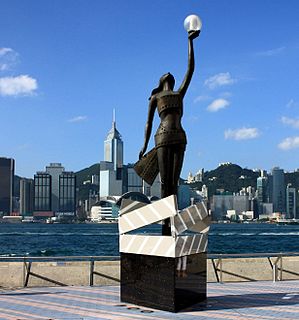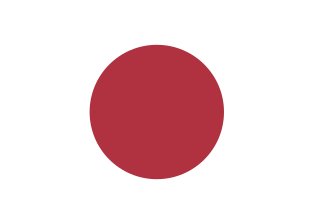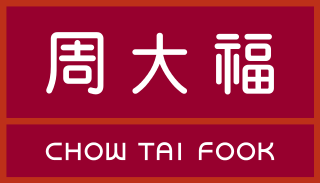
Hong Kong, officially the Hong Kong Special Administrative Region of the People's Republic of China (HKSAR), is a metropolitan area and special administrative region of the People's Republic of China on the eastern Pearl River Delta of the South China Sea. With over 7.5 million residents of various nationalities in a 1,104-square-kilometre (426 sq mi) territory, Hong Kong is one of the most densely populated places in the world.

The cinema of Hong Kong is one of the three major threads in the history of Chinese language cinema, alongside the cinema of China, and the cinema of Taiwan. As a former British colony, Hong Kong had a greater degree of political and economic freedom than mainland China and Taiwan, and developed into a filmmaking hub for the Chinese-speaking world.
The existing Hong Kong honours system was created after transfer of government of Hong Kong to the People's Republic of China as a special administrative region in 1997. Before that, Hong Kong was a British dependent territory and followed the British honours system. The HKSAR Government does not maintain any records of pre 1997 awards including gallantry awards.

The Imperial Japanese occupation of Hong Kong began when the Governor of Hong Kong, Sir Mark Young, surrendered the British Crown colony of Hong Kong to the Empire of Japan on 25 December 1941. The surrender occurred after 18 days of fierce fighting against the overwhelming Japanese forces that had invaded the territory. The occupation lasted for three years and eight months until Japan surrendered at the end of Second World War. The length of this period (三年零八個月) later became a metonym of the occupation.

The Cantonese people or Yue people, are a Yue-speaking Han Chinese sub-group originating from or residing in the provinces of Guangdong and Guangxi, in Southern Mainland China. Although more accurately, "Cantonese" refers only to the people from Guangzhou and its satellite cities and towns and/or native speakers of Standard Cantonese, rather than simply and generally referring to the people of the Liangguang region.

Sir Robert Ho Tung Bosman,, also known as Sir Robert Ho Tung, was a Hong Kong businessman and philanthropist in British Hong Kong. Known as "the grand old man of Hong Kong", he was knighted in 1915 and 1955.

Lyndhurst Terrace is a street in the Central area of Hong Kong. Built on a slope in southern Central district, the terrace links Hollywood Road and Wellington Street, at its intersection with Pottinger Street. In the middle it meets Gage Street, Cochrane Street and the Central-Mid-Levels escalators.

Chow Tai Fook group is a Hong Kong–based privately owned conglomerate that engaged in the jewellery, property development, hotel, department store, transportation, energy, telecommunications, port, casino and other businesses. Despite the holding companies of the group, namely Chow Tai Fook Capital Limited, Chow Tai Fook (Holding) Limited, Chow Tai Fook Enterprises Limited, etc. were privately owned, the group was partly floated in the public, via associate company New World Development and subsidiary Chow Tai Fook Jewellery Group Limited. As of 31 December 2018, New World Development was ranked as the 47th largest companies of the Stock Exchange of Hong Kong by market capitalization, which was HK$105.68061 billion.
The four big families of Hong Kong is a term used to describe the four Chinese–Hong Kong business families who rose to prominence and became influential during the era of British colonial rule in Hong Kong. In order of influence, they are Li, Ho, Hui and Lo. Some who use the term have replaced the Hui family with the Fu family, headed by Fu Tak-iong, while others have substituted Chau and Lee - in reference to Chau Wing-tai, Chau Sik-nin and Lee Hysan - for the Hui and Lo families, respectively.

Gresson Street is a street in the Wan Chai area of Hong Kong Island, Hong Kong. It connects Queen's Road East (south) to Johnston Road (north).

Hedwig Marie "Hedda" Morrison was a German photographer who created historically significant documentary images of Beijing, Hong Kong and Sarawak from the 1930s to the 1960s.
Spacked Out is a 2000 Chinese social realist film directed by Lawrence Ah Mon and produced by Johnnie To. It has a Category III rating in Hong Kong.

The Central and Western District located on northwestern part of Hong Kong Island is one of the 18 administrative districts of Hong Kong. It had a population of 243,266 in 2016. The district has the most educated residents with the second highest income and the third lowest population due to its relatively small size.

Shelley Street is a street in Central, Hong Kong. It is a ladder street and the Central–Mid-levels escalators run along the entire length of the street.
The Hong Kong Special Administrative Region Basic Law Consultative Committee was an official body established in 1985 to canvass views in Hong Kong on the drafts of the Hong Kong Basic Law.
The Progressive Hong Kong Society was a political group in Hong Kong. It was established on 14 February 1985 by the then Executive and Legislative Council member Maria Tam. The party is considered conservative and pro-Beijing, in contrast to the pro-democracy forces which rose to prominence in the late 1980s and early 90s.
The Group of 89 or Business and Professional Group of the Basic Law Consultative Committee was a conservative political pressure group formed by the conservative business and professional elites led by tycoon Vincent Lo in the Hong Kong Basic Law Consultative Committee (BLCC) and Hong Kong Basic Law Drafting Committee (BLDC) during the drafting period of the Hong Kong Basic Law in the late 1980s. Compared to the Group of 190 set up by the pro-democracy groups, it was on the conservative side of debates over the constitutional reform, the Hong Kong Basic Law and the future of Hong Kong.
Tchan Fou-li was a Hong Kong photographer who worked to develop distinctive Chinese forms of photography and to establish photography as a serious art form in Hong Kong. He is known for his photographs, described as evoking the artistic values and composition of Chinese landscape paintings. A New York Times reviewer called him "one of the great visual artists of his time" because of his "carefully crafted images that celebrate the beauty of the human condition and the majesty of nature."
The election for the Hong Kong deputies to the 10th National People's Congress (NPC) was held on 3 December 2002. 36 Hong Kong deputies were elected by an electoral college.
Holly Lee, born 1953 in Hong Kong, is an artist-photographer, best known for her portraits project, the Hollian Thesaurus. She was one of the pioneers of conceptual photography in Hong Kong, experimenting with Photoshop to create composite photographs that were reminiscent of oil paintings. Her work has been collected by the Hong Kong Heritage Museum and M+ Museum.










